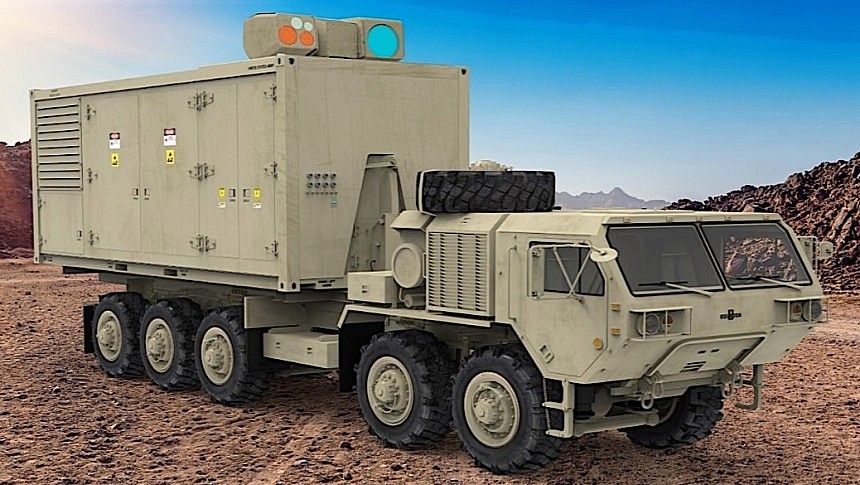For a soldier traveling into the future from say the 1980s, the battlefields of today would be unrecognizable. What was known to be essential, in terms of hardware, to a mission's success is now obsolete, and there are so many new weapons being employed that no amount of the age's training would have prepared said soldier for this reality.
Just think about. Tanks, once the workhorses of mechanized infantry units, now have to hold back as they have been relegated to the status of fixed artillery pieces by the invasion of ATGMs and, more recently, drones.
Then, drones are not the only new and deadly weapons flying over the battlefields right now. We've got hypersonic missiles, smart or less so rockets, GPS-guided artillery shells, and even mortar rounds that know where to land to make the most damage.
What a 1980s soldier would need to survive, just like the ones of our time, is a modern defense system against these threats. Like, say, a badass laser system that's capable of targeting and destroying UAVs, rockets, artillery, mortars, and even fixed and rotary wing aircraft long before they reach their targets.
The American military has been working on such a thing for a while now, but only this week it decided who will make this fancy new defensive weapon: Lockheed Martin.
The system is known as the Indirect Fire Protection Capability-High Energy Laser (IFPC-HEL), and work on it has been going on for a while now. It started back in 2019 with something called the High Energy Laser Tactical Vehicle Demonstrator (HEL-TVD).
That one was a 100 kW-class laser Lockheed Martin put together as a means to show the military what it can do. The IFPC, on the other hand, is a 300 kW beast that should work in conjunction with other, more traditional means of defense.
The laser is designed to be deployed to protect fixed and semi-fixed assets from enemy weapons, but given how this is uncharted territory even for the U.S., some serious testing on operationally relevant targets will have to be conducted at first.
For that to happen Lockheed Martin was granted by the U.S. Army a contract of undisclosed value to make and deliver no less than four of these 300 kW-class lasers. All of them will be based on the "most powerful solid-state directed energy technology delivered" by the company last year, the High Energy Laser Scaling Initiative (HELSI) laser, but the exact specifics of the weapon were not disclosed.
It's unclear when exactly we are to expect the lasers in action, but we do know the Army wants them ready to go as soon as possible, especially given the current volatile, close to explosive status of the world we live in.
Then, drones are not the only new and deadly weapons flying over the battlefields right now. We've got hypersonic missiles, smart or less so rockets, GPS-guided artillery shells, and even mortar rounds that know where to land to make the most damage.
What a 1980s soldier would need to survive, just like the ones of our time, is a modern defense system against these threats. Like, say, a badass laser system that's capable of targeting and destroying UAVs, rockets, artillery, mortars, and even fixed and rotary wing aircraft long before they reach their targets.
The American military has been working on such a thing for a while now, but only this week it decided who will make this fancy new defensive weapon: Lockheed Martin.
The system is known as the Indirect Fire Protection Capability-High Energy Laser (IFPC-HEL), and work on it has been going on for a while now. It started back in 2019 with something called the High Energy Laser Tactical Vehicle Demonstrator (HEL-TVD).
That one was a 100 kW-class laser Lockheed Martin put together as a means to show the military what it can do. The IFPC, on the other hand, is a 300 kW beast that should work in conjunction with other, more traditional means of defense.
The laser is designed to be deployed to protect fixed and semi-fixed assets from enemy weapons, but given how this is uncharted territory even for the U.S., some serious testing on operationally relevant targets will have to be conducted at first.
For that to happen Lockheed Martin was granted by the U.S. Army a contract of undisclosed value to make and deliver no less than four of these 300 kW-class lasers. All of them will be based on the "most powerful solid-state directed energy technology delivered" by the company last year, the High Energy Laser Scaling Initiative (HELSI) laser, but the exact specifics of the weapon were not disclosed.
It's unclear when exactly we are to expect the lasers in action, but we do know the Army wants them ready to go as soon as possible, especially given the current volatile, close to explosive status of the world we live in.






